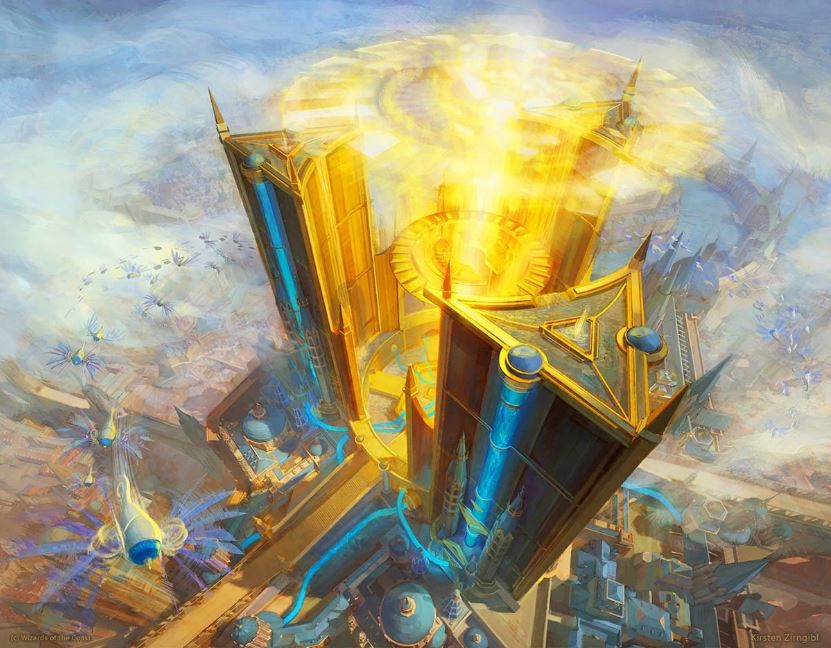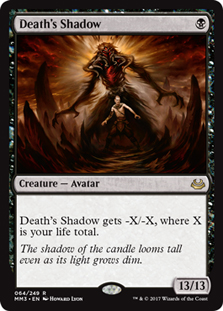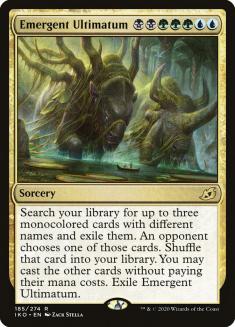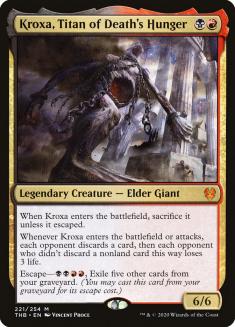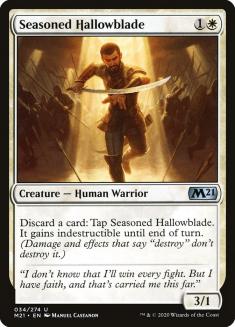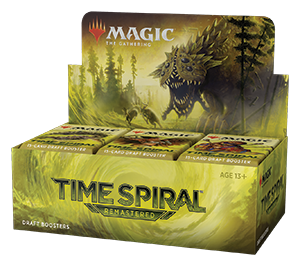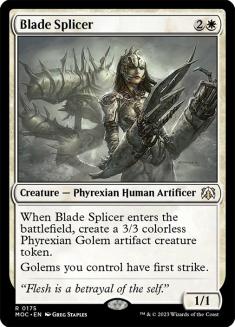Welcome to Fact or Fiction! Today, Dom Harvey, Paulo Vitor Damo da Rosa, and Ross Merriam give their takes on five statements about the current state of Magic: The Gathering. Don’t forget to vote for the winner at the end!
1. Historic Anthology IV will make a large impact on Historic for the Kaldheim Championship.
Dom Harvey: Fiction. I love Thraben Inspector as much as the next person (and if you don’t love it, I don’t know if we can be friends) but it’s more of a glue card with a subtle influence than a card that seizes your attention and demands respect. I don’t think its printing makes or breaks any new archetype and there are existing white decks that don’t want it (namely Azorius Control or anything leaning too heavily on Yasharn, Implacable Earth).
Death’s Shadow is a fascinating deckbuilding puzzle in a format that lacks fetchlands to make it easy but has enough good self-damaging cards to make it worthwhile. I want it to be good, but the decklists look so odd on paper and there are zero results to work with yet, so it’s hard to be sure. Historic looks quite aggressive and creature-centric right now, so taking too much damage comes with a real cost.
Normally if you went card-by-card, you’d be here forever but… those are the only cards that anyone seems to care about? I guess Declaration in Stone is a useful removal option and there might be some Cycling deck that wants Flameblade Adept (and one wonders why it’s here instead of in Amonkhet Remastered). Sawtusk Demolisher is also here for some reason. The Historic Anthology series seems to be more confusing than exciting these days.
Paulo Vitor Damo da Rosa: Fiction. I think Historic Anthology IV is a remarkably weak set, and I would honestly be shocked if it made a large impact. There are a couple of cards that have been good before, like Death’s Shadow, but they really just lack the supporting cast that made them good to begin with — without fetchlands the card becomes a lot worse and you also don’t have a Temur Battle Rage to push it through.
I see a lot of people in love with Thraben Inspector but I don’t consider that card to be particularly good — it filled a role when you needed a one-drop artifact or a cheap creature to go wide with, but it’s a role-player more than anything and I don’t think the lack of a one-mana artifact was what was holding Mardu Vehicles back. It doesn’t fit cleanly into any of the existing decks and it’s not powerful enough to spawn an entirely new deck, so I’m not sure how interested I am in that.
Ross Merriam: Fact. The big story is Death’s Shadow, and I’m already seeing some decklists with the card that look quite promising. We might not have fetch-shock manabases, but there’s enough to cast early Shadows consistently, and Thoughtseize is already one of the best cards in the format, so you don’t have to fill your deck with bricks in order to enable your threat. I expect to see these decks refined in the coming days and contend next weekend.
But that’s not all this set offers. Thraben Inspector is guaranteed to be a quiet contributor to several decks, Blinkmoth Nexus is one of the best creature-lands ever printed, Inspiring Statuary is sending every combo mage scrambling for their Paradoxical Outcomes, and Flameblade Adept makes Historic Cycling Aggro an intriguing possibility.
I’m not saying that all these cards will have a significant impact right away, but if only half of them are early hits, that’s quite a performance for a 25-card set.
2. Kaldheim Standard is the best Standard format Magic has had in the past three years.
Dom Harvey: Fiction (but it’s in the mix). I’ve enjoyed Kaldheim Standard a good amount but part of me wonders if I’m simply relieved to have a playable format again after a truly brutal year for Standard. The pandemic has scrambled my sense of time, and we’ve had so many failed formats back-to-back-to-back that it’s easy to forget that Jeskai Lukka (Yorion) with Fires of Invention and fully powered companions was less than a year ago or that Omnath, Locus of Creation was legal in Standard for all of two weeks. An average format would be a breath of fresh air in that context.
I also have to question if I’m liking it because it’s the only format I feel comfortable in right now — confusing ‘good’ with ‘good for me’ is a classic Magic player problem. The gameplay itself can be very swingy, with most decks still revolving around some pushed Throne of Eldraine card or single-card engines like Emergent Ultimatum or Showdown of the Skalds.
That said, there’s more diversity in this format than in any Standard format in recent memory. True aggro is back, with Mono-White Aggro❄ and Mono-Red Aggro❄ both performing well and the Gruul Adventures shell from Zendikar Rising Standard surviving the addition of Kaldheim. Dimir Rogues is an aggro-control deck (already uncommon) that has a unique playstyle and changes what the game is about.
There are at least four distinct Naya Adventures decks — Reid’s midrange approach focusing on The Great Henge, the low-curve Clarion Spirit deck, an aggressive version with Embercleave, and Naya Fury with Goldspan Dragon — and Temur Adventures has showed up in various forms too. Doom Foretold based decks have reappeared with a new look. Of course, a Sultai Ramp deck is once again looming over the format and issuing an Emergent Ultimatum.
I said Fiction because I think there are other formats that have a similar level of diversity but more stable gameplay. Ravnica Allegiance Standard comes to mind, which was fittingly the last format before War of the Spark brought a dramatic spike in power level that we’re still recovering from.
Paulo Vitor Damo da Rosa: Fiction. I know this is an unpopular take, but I don’t love this Standard format. To me, there are two different qualities a format can have — deck diversity and gameplay. This format has deck diversity in spades; you can play whatever you want and succeed. That’s pretty good. However, I think the gameplay suffers a bit because the matchups are too lopsided.
In Zendikar Rising Standard every matchup was 55/45. You could tune your deck to beat a certain deck and then you’d move to 58/42. There was never any deck you couldn’t beat and the game was never defined before it began.
Kaldheim Standard, on the other hand, is a bit like Modern — there are a lot of viable decks with lopsided matchups. If I’m playing Rakdos Midrange versus Mono-White Aggro❄ or Sultai Ramp (Yorion), should I even play the games? I can’t beat Sultai and can’t lose to Mono-White regardless of what happens. This is an exaggeration, but not a very big one — they’re very lopsided matchups.
You could argue that it’s my choice to be a part of that when I decide to play Rakdos Midrange, but what about the Sultai or Mono-White pilots? They’re also in the exact same situation, a game mostly decided before hands are even drawn. If this happens with most of the decks, it’s not really avoidable and I really dislike this situation.
This is not to mention the swingy sideboard cards. Playing versus Mono-White Aggro❄? Whether you decided to have Archon of Absolution in your sideboard or not, and whether you draw that card specifically or not, is a huge swing in percentage. I like it a lot more when sideboard cards are of the “Glass Casket” variety than the Archon of Absolution variety. So, yeah, I understand that for some people diversity is the most important thing, so they love this format, but not me – I like balanced matchups where playing the game, rather than the pairings, decides who wins.
Ross Merriam: Fiction. Obviously the bar here is low, and I’ll admit that this season would rank near the top. But it’s not number one. That honor belongs to Guilds of Ravnica and Ravnica Allegiance. That fall started with Mono-Red Aggro and Selesnya Tokens. By the end of that season the metagame was Golgari Midrange, Izzet Drakes, and Mono-White Aggro.
Following Ravnica Allegiance, we saw the Golgari decks splash blue for Hydroid Krasis as well as the emergence of Mono-Blue Aggro. I may be a bit biased, but any format where Pteramander and Curious Obsession appear in a top-tier strategy is healthy. These decks form a natural check on the midrange arms race that is much more interesting than a linear aggro strategy. Of course, this format did have decks that went over the top, like Simic Reclamation and Five-Color Gates. And Esper Control was around for the Shaheen Sooranis of the world.
These two seasons had decks for everyone, interesting deckbuilding decisions for each archetype, and enjoyable gameplay. I’d put Ravnica Allegiance ahead by a nose because of the unique presence of Mono-Blue Aggro, but you can’t go wrong either way. Unfortunately it gets overshadowed by the dark year that followed, with Field of the Dead; Oko, Thief of Crowns; Uro, Titan of Nature’s Wrath; Fires of Invention; etc. trading off periods of domination.
Guilds of Ravnica and Ravnica Allegiance were great Standard environments. The current one is merely good.
3. You’re excited to draft Time Spiral Remastered.
Dom Harvey: Fact. It takes a lot to get me excited for a normal Limited format but this one has a certain nostalgia for me (on top of the nostalgia baked into the concept of Time Spiral) – I started playing not long before Time Spiral and its release inspired me to learn everything I didn’t already know about Magic’s history to fully appreciate the set. I don’t like being reminded that the gap between Time Spiral and Time Spiral Remastered is longer than the gap between Alpha and Time Spiral (Do you feel old yet? Do you?!) but I like everything else I see (and don’t see — don’t let the door hit you on the way out, Sprout Swarm!).
Paulo Vitor Damo da Rosa: Fiction. I love drafting and I miss doing it competitively, but there’s no room for online drafting in my life while it’s not a part of competitive Magic. Right now we have Historic and Standard to test for and to write about, so there’s just no time for learning an entirely new draft format. I’ve also become too used to the Arena interface to go back to Magic Online (MTGO) at this point; if I could draft it in person, then maybe I’d be excited, but right now I can’t even go to the supermarket. Maybe once this is over, if the format looks particularly fun, I’ll get back to it.
Ross Merriam: Fact. I’m a curmudgeonly old man. Few things excite me. Normally the list is just beating Corey Baumeister on VS Live! and watching the Utah Jazz win a basketball game (bonus points if it’s against the Rockets or the Lakers).
But nothing warms a curmudgeon’s cold, dead heart quite like a healthy dose of nostalgia. I loved drafting Time Spiral, even though I had to walk ten miles uphill in the snow to the game store to do it.* It was sort of like a precursor to drafting Cube, where you saw so many strange interactions between cards and mechanics that never existed together before. In particular I remember setting up some awesome storm turns with various suspend cards. With Empty the Warrens coming back I’ll be sure to hop right on that bicycle.
*Narrator voice: he walked one mile along a flat street in sunny Southern California.
4. Magic art as NFTs is a good idea.
Dom Harvey: Fiction. Look, anyone reading this (on the website of a large Magic retailer) has an interest in collectible cardboard whose monetary value is entirely based on its artificial scarcity. Perhaps you’ve avoided all of that and just dabble in MTGO or MTG Arena, which have completely different models that are each highly flawed and greedy in their own ways. The economic basis for any form of Magic looks as absurd to outsiders as NFTs of Magic art should be to us.
With that caveat… this is the easiest answer I could give to a Fact or Fiction question? I have yet to see a good argument for why NFTs are a necessary or useful concept in general and introducing them here has no clear use for artists themselves or people with a genuine interest in owning Magic art (who has any sentimental attachment to a NFT?). As far as I can tell, its appeal is to people who want to make easy money without producing anything of value. I guess it’s some small comfort that this doesn’t have the same obscene environmental impact as the ‘normal’ cryptocurrency stuff that the same crowd goes wild for.
Paulo Vitor Damo da Rosa: Fiction. I will be honest and say it’s hard for me to have a strong opinion on this, given that I literally had to ask “Cedric, what’s an NFT?” before answering this question, but I guess I just don’t truly get it? From what I read, you don’t actually get the rights to the art – it’s still owned by Wizards of the Coast (WotC), who commissioned it – so what exactly are you getting?
To me, the whole point of buying a piece of Magic artwork is that you get it and then you can hang it wherever you want, look at it, display it. If you’re buying an online thing that you don’t actually own the rights to, then what exactly are you doing with it? Is the entire point to re-sell it later and that’s it?
I believe consenting adults should be free to engage in whatever they want, so if ultimately someone really decided to buy a Magic art as NFT and the artist wants to sell it then this is not something that I think should be stopped, but I also think a lot of things have to be clarified (such as “What did I actually buy?”) before those become commonplace in Magic. So maybe it’s a good idea in the future, but in its current form, it does not look like a good idea to me.
Ross Merriam: Fiction. If you really want my opinion, then there it is, but my knowledge in this area is slim to none so I’ll refrain from offering a long-winded explanation that only serves to obfuscate that ignorance with flowery language and false bravado. Based on what I do know, I frankly don’t see the benefit or appeal.
5. You’d first-pick Blade Splicer over Channel Pack 1, Pick 1 in Vintage Cube.
Dom Harvey: Fact? Or rather, I wouldn’t fault you for doing so. I’ve been vocal in questioning some other picks we saw this weekend (see my article this week!) but I actually like this one. Channel has an incredibly high upside but is narrow, hard to cast, and often needs a lot to go right — Turn 2 Channel into Emrakul, the Aeons Torn will end any game, whereas Turn 4 Channel into Blightsteel Colossus is a much riskier proposition. I’d still take it because I want to live that dream, but Blade Splicer is a fantastic card that goes in any white deck and is easy to splash or cast with fast mana if you can get some (a Mana Crypt, perhaps?).
Paulo Vitor Damo da Rosa: Fiction. It’s been a long time since I’ve played Vintage Cube and I have never played this particular iteration of it, but I can’t imagine first picking Blade Splicer. This isn’t to say that this is wrong (Jan-Moritz Merkel did have an absurd win-rate before the event and went on to win it, and I’m not nearly confident enough about it to say he’s incorrect), but I honestly wouldn’t even know what to do with a Blade Splicer, as I only draft Cube for fun, and when I do I just never draft these decks. It’s not an exaggeration to say that I would rather shuffle the pack and take a random card from it than take Blade Splicer, but this is of course mostly speaking about my shortcomings than the correctness of the pick.
Ross Merriam: Fact. In most cases I’d take the Channel, but I will absolutely defend taking the Blade Splicer as part of a larger plan. There was a time, before it was popular, that I was forcing Mono-White Aggro in every Vintage Cube draft, and in one of those I would absolutely take the Splicer. I think green ramp decks are among the more overrated archetypes in Vintage Cube, while Blade Splicer is among the most underrated cards, because it can fit into a wide variety of decks and be effective.
Efficient creatures, planeswalkers, and cheap interaction make a winning recipe that most people ignore in Vintage Cube because of the common mantra that you have to be doing something broken. That advice is nonsense and if you care about winning you should ignore it.
Cube is not well-understood because it’s rarely played for high stakes, and in that environment it’s easy for a few loud voices to dictate to the masses. But I trust those voices about as much as I trust the old fart on the baseball diamond screeching about RBIs. I suspect that a year of high-level Cube tournaments would completely reshape our understanding of the format, and we’ll move in the same direction, albeit more slowly, as more players in high-stakes Cube drafts are willing to go against the grain like this because they’ve figured out something that no one else knows.

